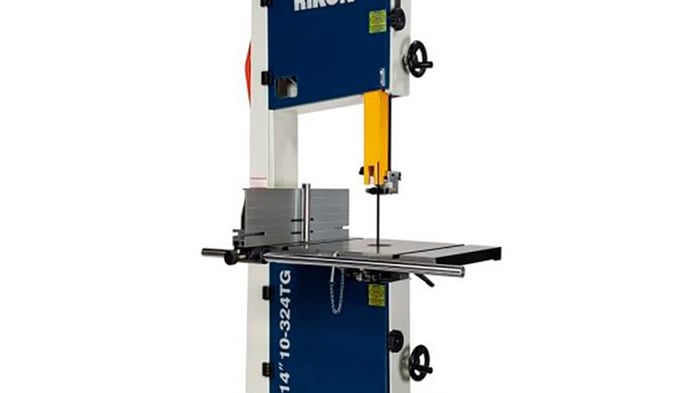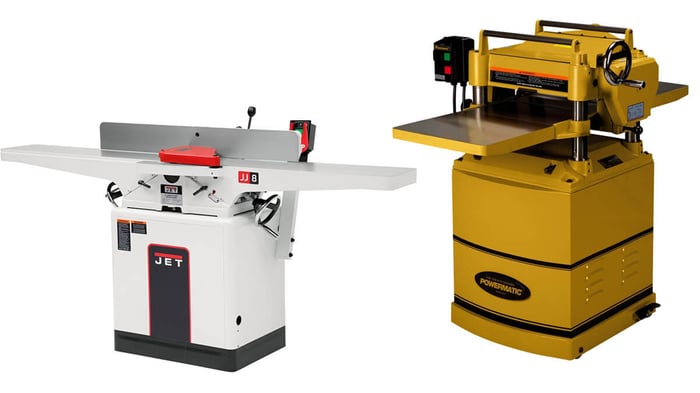
Ensuring Accuracy with Your Bandsaw
If you're looking to elevate your woodworking skills, mastering the bandsaw is key. Let's dive into the different parts and functions of the bandsaw, why accuracy is so important when using it, and what factors can impact how precise your cuts are.
We'll also cover tips for maintaining accuracy, safety precautions to bear in mind, and how to troubleshoot any common issues that may affect your precision. Get ready to unlock the full potential of your saw for flawless and efficient woodworking projects.
Understanding the Bandsaw
Regarding woodworking, having a bandsaw in your workshop can totally change the game. This power tool is versatile and essential for all sorts of cutting tasks.
Whether you're working on crafting intricate furniture pieces, shaping curved edges, or making precise cuts, it gives you the precision and efficiency you need for your woodworking projects. It's not just about ripping large boards; this tool can handle intricate patterns and a variety of materials and cutting techniques, making it a must-have for anyone who loves woodworking.
Its ability to effortlessly cut through thicker stock with accuracy really makes it stand out in your workshop, allowing you to get creative and precise with all your woodworking projects.
Parts and Functions
Understanding the different parts and functions of a bandsaw is crucial for you to use this tool effectively. From the blade guide to the blade guard, each component plays a vital role in operation.
The blade guide is a critical component as it helps to keep your blade in place and properly aligned during cutting. It ensures that your blade stays on track and does not wander off course, resulting in precise and accurate cuts.
On the other hand, the blade guard serves as a safety feature, protecting you from accidental contact with the moving blade. By understanding how these components work together, you can enhance your woodworking experience and achieve optimal results in your projects.
Importance of Accuracy
In your woodworking projects, nailing down the accuracy of any saw is key to getting those perfect cuts. Precision is the secret sauce that takes your creations from good to great.
When you're working with a bandsaw, even the tiniest slip-up in precision can throw off your cuts and mess with the final result of your project. It's not just about measuring twice and cutting once - it's also about expertly handling and adjusting the saw throughout the entire cutting process. Paying close attention to the details, like keeping the blade tension consistent and ensuring proper alignment, is crucial for hitting that sweet spot of precision in your woodworking projects.
Benefits of Precision
In woodworking, precision is your best friend, bringing a ton of perks your way. It's all about sharpening those woodworking skills and perfecting your craft, letting you whip up detailed designs and flawless finishes.
When you work with precision in woodworking, you're setting yourself up for success. Getting those measurements spot-on and sweating the small stuff helps you nail accuracy and keep things consistent across all your projects. Not only does this attention to detail amp up the overall quality of your work, but it also boosts the functionality and durability of your creations. Getting the hang of precision in woodworking isn't just about looks; it's about making sure your pieces can stand the test of time. And once you've mastered this art, get ready to take on more challenging projects that push your skills and unleash your creative side.
Factors Affecting Accuracy
There are a few key factors you need to keep in mind to get those precise results.
- Blade selection is super important because different blades are made for different materials and cutting tasks. So, make sure you're using the right one for the job.
- Don't forget about the regular maintenance of your machine - keeping the blade sharp, correctly tensioned, and tracking properly is crucial for top-notch performance.
- You've got to know the cutting capacity of your saw; understanding its limits will help you avoid any blade or machine mishaps.
By taking these factors into account, you'll be on your way to more accurate and long-lasting cuts.
Blade Selection and Maintenance
Regarding your bandsaw, choosing the right blade and keeping it well-maintained are crucial for getting those precise cuts you're aiming for. Don't forget about other factors like blade speed that also play a role in how your tool performs.
When you're picking out a blade, think about the material you'll be cutting. Different blades are made for different jobs. For example, if you're working with delicate materials, a fine-toothed blade is your best bet. But if you're tackling thicker materials, a coarse-toothed blade is the way to go.
Taking good care of your blade with regular cleaning and tension adjustments is key to making sure it lasts and gives you accurate cuts. Blade speed is another factor to keep in mind. Higher speeds usually mean smoother cuts, but you'll need to be extra careful with your control.
By getting a handle on these key factors and tweaking them to fit your needs, you'll be able to boost the precision and efficiency of your saw.
Proper Setup and Adjustment
Ensuring the proper setup and adjustment of your bandsaw is crucial for optimal performance. From blade alignment to fence adjustment and blade tension, each adjustment affects the accuracy of your cuts.
You want to make sure that your blade is aligned just right to keep it on track while you're cutting, preventing any wobbling or drifting. Adjusting your fence properly is key to keeping those cuts consistent, giving your workpiece the support and guidance it needs. And don't forget about blade tension – it's what helps your blade slice through materials smoothly. Following the recommended setup procedures for these factors will step up your bandsaw game, improving the accuracy and efficiency of your cuts.
Techniques for Ensuring Accuracy
Employing the right techniques is essential for ensuring accuracy when using a bandsaw. You need to make sure you're using guides, practicing proper cutting techniques, and referencing alignment guides to achieve precise results.
Guides play a crucial role in keeping the blade aligned and ensuring straight cuts. When you use guides, you can keep a consistent cutting path, leading to clean and accurate cuts. Remember to maintain steady pressure and feed the material at a consistent pace to enhance cutting precision. Alignment guides are your best friend in setting up initial cuts accurately and ensuring subsequent cuts follow the same line. These tools give you a visual reference point to keep your cutting alignment on point.
Using Guides and Fences
Regarding improving the accuracy of your bandsaw cuts in woodworking projects, you can't go wrong with guides and fences. Make sure you adjust and align your fence properly to get those precise results.
Guides are your best friend when it comes to maintaining consistency and accuracy while cutting. They keep your workpiece secure and prevent any unwanted movement, leading to cleaner cuts and fewer mistakes along the way. Plus, using guides can up your safety game by giving you a stable platform for your material, reducing the chances of kickback or accidents. Taking the time to set up your guides and fences with precision and attention to detail can really step up the quality of your woodworking projects.
Proper Cutting Techniques
Mastering proper cutting techniques is crucial for refining your woodworking skills and ensuring top-notch results. If you follow the best practices, you can nail those bandsaw cuts with exceptional precision.
Regarding operating a bandsaw, you've got to use the right approach to avoid mistakes and wasting materials. Knowing how to position the wood, adjust the blade tension just right, keep a steady feed rate, and make those precise cuts are all key parts of mastering the bandsaw.
Getting the technique down not only boosts the quality of your woodworking projects but also ramps up efficiency in your workflow. By incorporating best practices like using push sticks for safety, keeping your blade well-maintained, and picking the right blade for the material you're cutting, you can seriously level up your woodworking game.
Safety Measures for Accurate Bandsaw Use
Regarding using a bandsaw, you've got to prioritize safety above all else. Make sure you've got all the necessary safety gear on - think safety glasses, ear protection, and gloves - to keep yourself protected from any potential dangers.
Don't forget about following those safety precautions too. Keep your workspace tidy, check that blade tension, and never operate the bandsaw when you're feeling worn out. These steps are key to creating a safe working environment.
And hey, take advantage of those safety features on the bandsaw. Blade guards, emergency stop switches, and getting the proper training on how to use the machine all add an extra layer of safety. By putting all these safety measures into practice, you're not just looking out for yourself - you're also setting the standard for a safety-first culture in the workshop.
Protective Gear and Precautions
When using a bandsaw, make sure you prioritize your safety by wearing the right gear and taking necessary precautions. It doesn't matter if you're a beginner or a pro, safety should always come first.
Don't skip out on safety measures when working with a bandsaw. Gear up with gloves, safety goggles, ear protection, and a dust mask to keep yourself protected from any potential harm. These safety tools are there to lower the risk of injuries from wood bits, flying debris, loud noises, and harmful dust particles.
To prevent accidents while using a bandsaw, pay attention to your surroundings, keep your workspace tidy, and stick to the correct operating procedures. These simple steps can go a long way in reducing the chances of mishaps.
Troubleshooting Common Accuracy Issues
If you're running into accuracy problems with your bandsaw cuts, it can be super frustrating. But don't worry, knowing how to troubleshoot common issues can help you fine-tune your cutting precision and get those perfect cuts you're looking for.
One common problem that woodworkers often face is blade drift, where the blade goes off track during a cut, messing up your cuts. To tackle blade drift, start by checking the blade tension and alignment. Also, make sure your blade is sharp because a dull blade can cause drift. Keeping the fence aligned and secure is also crucial to reducing drift and improving your cutting accuracy.
Identifying and Fixing Problems
Regarding maintaining your bandsaw's accuracy, identifying and fixing issues is key. Troubleshooting problems like blade tracking and tensioning can make a big difference in achieving precise cuts.
If you notice uneven cuts or drifting while using your bandsaw, blade tracking might be the culprit. Check that the blade is aligned correctly and running smoothly on the wheels. Adjusting the blade guides and making sure the tension is just right can help resolve tracking issues. Inadequate tension can result in subpar cuts and premature wear on the blade. Watch the blade tension and make adjustments as necessary to keep your cuts on point. Addressing blade tracking and tensioning problems promptly is crucial for getting consistent and accurate bandsaw cuts.
Frequently Asked Questions
What steps can I take to ensure the accuracy of my cuts?
To ensure accuracy when using your bandsaw, first make sure that the blade is properly tensioned and aligned. Additionally, regularly check and adjust the fence and blade guides, and always use a sharp blade.
Why is it important to maintain a consistent feed rate?
Consistency in feed rate is crucial for accuracy when using a bandsaw. This helps to prevent uneven cuts and ensures that the blade stays on track, resulting in precise and clean cuts.
How can I minimize blade drift?
To minimize blade drift, make sure that the blade is properly tensioned and aligned. You may also need to adjust the fence and blade guides, and use a slow and steady feed rate.
What should I do if my cuts are not coming out straight?
If your bandsaw cuts are not coming out straight, check the blade tension and alignment first. Additionally, make sure that the blade guides and fence are properly adjusted, and try using a fresh, sharp blade.
Is it necessary to use a fence?
Using a fence is highly recommended when making cuts on a bandsaw to ensure accuracy. A fence helps to guide the workpiece and keep it in place, resulting in straight and precise cuts.
How often should I check and adjust my blade tension and alignment?
It is recommended to check and adjust the blade tension and alignment on your bandsaw every time before using it. This will ensure the best possible accuracy and prevent potential issues during the cutting process.





